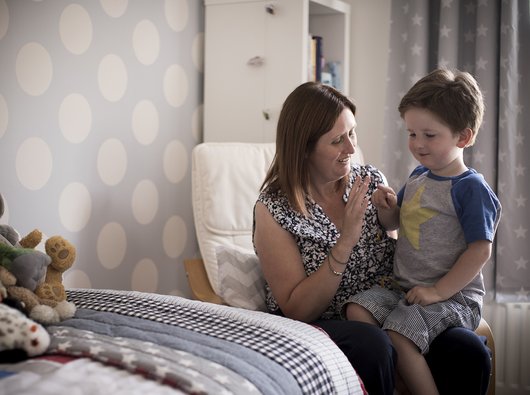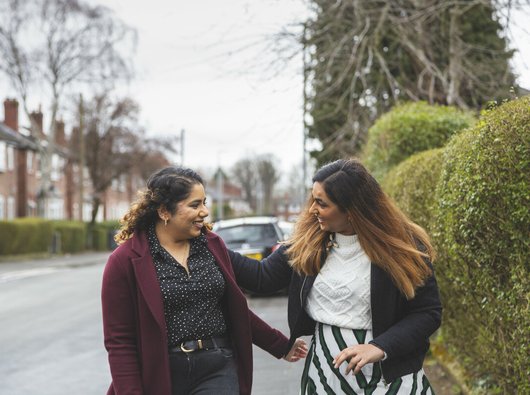Treatment for childhood acute lymphoblastic leukaemia (ALL)
Acute lymphoblastic leukaemia (ALL) is a very treatable cancer in children and young adults. The aim of treatment is to get rid of the leukaemia cells and help the bone marrow to work normally again.
Treatment decisions
Treatment for ALL is usually a combination of chemotherapy and steroids. It may involve other medicines as well.
Your child’s doctor will explain their recommendations and you will be able to ask questions so you can have the information you need to make decisions.
Parental responsibility
Young adults aged 16 and over have the right to make their own medical decisions. For children under 16, parents or carers are responsible for medical decisions, although children should be included as much as possible.
- Parents and carers may find it helpful to read our information about managing your child’s treatment and looking after a child with leukaemia.
- Young adults aged 16 or over may want to read our information for young adults with blood cancer.
Babies with ALL
Babies under one year old will have different treatment from older children. If you have a child with ALL who is under one, your consultant (specialist doctor) will discuss the treatment options with you.
Currently all babies with ALL in the UK are treated according to national guidelines. The aim is to make the treatment as effective as possible for this vulnerable age group while minimising any harm from the treatment itself.
Your consultant will recommend a treatment plan based on specific features of the leukaemia, including your baby’s age and how well each course of treatment clears the leukaemia cells. It may include targeted treatments such as immunotherapy, CAR T-cell therapy or a stem cell transplant along with chemotherapy.
Treatment planning
Treatment normally starts soon after diagnosis. You will be given a treatment plan that tells you which drugs your child will have. Your hospital team may call this a protocol or a regimen.
Treatment is divided into several stages. The overall aim is to get rid of all the leukaemia cells and stop the ALL coming back. It is also to give your child the right amount of treatment, so it cures the ALL but causes fewer side effects.
Many children and young adults with cancer are treated in a clinical trial. This is where treatment options are compared to see which brings the best results.
Trials help doctors find new treatments and improve current ones. For patients, they offer the chance to have a new treatment that might not be available otherwise.
If your child hasn’t had treatment for ALL before, they are likely to get the chance to join the latest clinical trial. If you (or your child, if they’re 16 or over) choose not to take part, they will have the best available treatment based on their age, the type of ALL they have and their test results.
Hugo's treatment for leukaemia
"I know that one of the projects Blood Cancer UK fund ensured that Hugo didn’t have to endure any more chemotherapy than absolutely necessary. I’m so grateful for that. "
Read Lisa's story about Hugo's treatment and recovery

The AllTogether-1 clinical trial
AllTogether-1 is a large international trial researching treatments for children and adults with ALL aged from one year to 45 years (up to 29 years in the UK). The trial is scheduled to run until May 2027.
In a trial, safety and wellbeing are always the priority. Your child will be closely checked during and after the trial and can withdraw at any time.
Below is an overview of the trial and the drugs involved. You can find more detailed information about AllTogether-1 on the Cancer Research UK website. Ask your hospital team to explain what the trial involves, and what the benefits might be.
Under the trial, treatment is divided into six stages:
- induction
- consolidation 1
- consolidation 2
- delayed intensification
- consolidation 3 (for some patients)
- maintenance.
The aim of induction is to destroy as many leukaemia cells as possible.
The three consolidation stages aim to destroy any remaining leukaemia cells. They also focus on stopping the leukaemia from spreading to the brain or spine (the central nervous system).
The aim of the delayed intensification stage of treatment is to carry on destroying leukaemia cells that don’t show up in tests.
Maintenance treatment is gentler and aims stop the ALL coming back.
Treatment groups
Doctors look at all the information they have about your child and the ALL, including their test results. They use this to assess their overall risk of relapse (the ALL coming back). This helps them decide how much treatment your child should have and how strong it needs to be.
The aim is to give each child or young adult the right amount of treatment to cure the leukaemia.
Under the AllTogether-1 trial, your child will be put in a treatment group based on their risk level. There are four treatment groups:
- standard risk
- intermediate risk – low
- intermediate risk – high
- high risk.
Treatment drugs may be given:
- intravenously (into a vein) through a central line – also known as an intravenous infusion
- as a tablet
- as a liquid medicine
- as an injection into a muscle or into the fluid in the spinal cord (cerebrospinal fluid)
We have more information about central lines and managing your child’s treatment.
Randomisation
It’s common for trials to include some “randomisation.” This means that people taking part in the trial are randomly chosen (by computer) to have a particular treatment. You will be told what the possible treatments are.
In the AllTogether-1 trial, your child’s treatment may be randomised at certain stages. For example, the trial aims to compare treatment with and without the drug inotuzumab ozogamicin before the start of maintenance chemotherapy, for intermediate risk patients.
Your child will have regular tests to make sure whatever treatment they are having is working. Your child’s doctor will always change their treatment if that is best.
Ask your doctor to explain the randomised parts of the trial and how they might apply in your child’s situation.
Treatment drugs
There’s a range of drugs that your child may have under the trial. Here is a list in alphabetical order. Some drugs are only given at certain stages and in certain circumstances.
– an enzyme (a drug that helps other drugs to work) which is injected into a large muscle, usually the thigh
– a monoclonal antibody which targets cancer cells so the immune system can find and attack them. Your child may have this if they have Down’s syndrome and are in one of the intermediate or high risk groups. They will have it as a continuous intravenous infusion through a central line.
– a chemotherapy drug given intravenously through central line
– a chemotherapy drug given intravenously through central line
– a chemotherapy drug given as an injection or intravenously through central line
– a steroid that is taken as a tablet or liquid.
– a chemotherapy drug given intravenously through central line
– an inhibitor, which blocks the growth of cancer cells. If your child has a type of ALL called Philadelphia positive ALL, or a mutation of the ABL gene, they may have this drug as part of their treatment. They will take it as a tablet.
– a monoclonal antibody which targets cancer cells so the immune system can find and attack them. Your child may have this before maintenance treatment if they would benefit from more treatment. They will have it intravenously though a central line.
– a chemotherapy drug taken as a tablet or liquid
– a chemotherapy drug that can be injected into the fluid that flows around the spine and brain (similar to having a lumbar puncture), taken by mouth as a tablet or liquid or given intravenously through a central line
– a chemotherapy drug. Your child may have this drug if they have high risk T-cell ALL. They will have it as intravenously through a central line.
– a chemotherapy drug given intravenously through central line
Information for young adults
For young adults with leukaemia and other types of blood cancer: your guide to treatment, side effects, coping with emotions, friends and work or study.

How long does treatment take?
Treatment will take around 2 ½ years. That’s the same whether or not your child is treated as part of the AllTogether-1 trial.
Will my child have to stay in hospital?
Your child will have most of their treatment in hospital as an outpatient, so they won't have to stay in overnight. But for some treatment, they will need to stay in hospital for a while. It’s the same whether or not they are in the AllTogether-1 trial.
Your child may also need to stay in hospital if they have an infection, which can be dangerous when they’re being treated for ALL.
If you are a parent, find out more about looking after a child with leukaemia.
If you are a patient, read our information for young adults with blood cancer.
Treatment side effects
Side effects are the unwanted effects of treatment. There are some potential short-term and long-term side effects from treatment for childhood ALL.
It’s important to understand that everyone is different and that although the list of potential side effects may be worrying, they’re unlikely to get all of them.
Your hospital team will also have effective treatments to help your child cope with side effects. This is known as supportive care.
We have general information on side effects of treatment for childhood leukaemia, and supportive care to help with them.
We also have information on common side effects for adults having blood cancer treatment.
If the ALL comes back
Sometimes ALL can come back. This is called a relapse. Relapse can happen either during treatment or after treatment has finished.
Relapse sometimes happens in the fluid around the brain and spinal cord. This is called a CNS relapse. For boys, it can also happen in the testicles. This is called an extramedullary relapse.
Relapsed ALL is harder to treat. But there are treatments for it, including more chemotherapy, immunotherapies, a stem cell transplant and CAR-T therapy. Your doctor will talk through the options
After treatment
At the end of the treatment, your child will have follow-up appointments to check there are no signs of relapse or complications from their treatment.
Towards the end of treatment, they may have a bone marrow biopsy to check that there are no leukaemia cells left. If the bone marrow is clear, this is called complete remission.
In the first year after treatment, your child will normally have a check-up every two to three months. They may have blood tests at these check-ups, but if the results are normal they won’t need another bone marrow biopsy. Over time they will need check-ups less often.
It’s very important to make sure that your GP is aware of the treatment your child has had for ALL. Doctors need a full medical history, even if the condition they’re diagnosing or treating is not related to the ALL.
Your hospital team should give you an end of treatment summary when treatment has finished.

Our research into childhood leukaemia
Childhood leukaemia has always been a focus for our research and is where we have some of our biggest breakthroughs.
